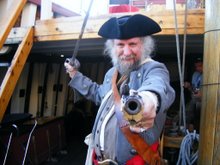One thing that I seldom see in navigational displays (including mine) is a parallel ruler. This was indispensable.
The parallel ruler is a pair of rulers connected by a pair of bars. The bars let you move the rulers apart but always keep them parallel.
In order to get from one place to another you need to know what course to use. One way to do this would be to use a protractor but period mapmakers usually provided ways of figuring your course without this. These require a parallel ruler.
One way was to include a compass rose on the map. You would mark the direction you need to follow then walk the ruler up to the compass rose to see what heading that corresponds with.
Period navigation was known as "loxodronic". Lines known as "loxodrons" would be drawn on the maps, usually in open spaces. These were conveniences and corresponded to headings. You lined up the course you needed to take then walked the parallel ruler across the map until you hit a corresponding loxodron. You then took your heading from the loxodron. These are longer than a compass rose and easier to match with.
Subscribe to:
Post Comments (Atom)


No comments:
Post a Comment